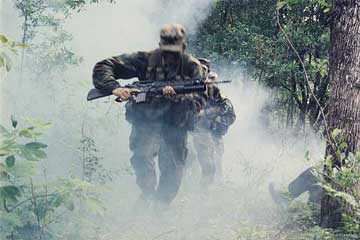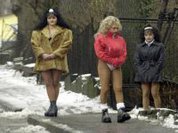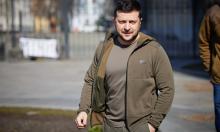U. S. Special Forces Enter the Intelligence World
 After a hiatus of nearly 30 years, the Pentagon’s elite Special Forces soldiers are preparing to fight in the shadowy world of “actionable intelligence,” covertly collecting information against terrorists and – most importantly – acting on that information with clandestine raids and attacks.
After a hiatus of nearly 30 years, the Pentagon’s elite Special Forces soldiers are preparing to fight in the shadowy world of “actionable intelligence,” covertly collecting information against terrorists and – most importantly – acting on that information with clandestine raids and attacks.
Recognizing the seriousness of the threat from non-state terrorist networks, it seems as though our national defense leaders in Washington, D.C., have finally gotten it right.
An article in The Washington Times on Feb. 19 revealed that Army “Green Berets” will soon begin training to assume the role of “spies” in addition to their traditional combat roles. Let’s not read too much into the term, “spies,” which is often a broad-stroke description of anyone involved in the intelligence business.
Normally, the intelligence networks that the Special Forces personnel have nurtured, and cultivated, have been in support of their own unit-unique initiatives and mission requirements.
But their collection skills have significantly improved with time and experience. As a result, various national-level intelligence agencies have shoehorned themselves into Special Forces intelligence operations that were initially designed for collection of tactical human intelligence. Many of these ops gained strategic and global intelligence direction as they yielded some unexpected bonanzas.
This marks a significant turnaround in the attitude of the U.S. intelligence community toward these elite soldiers. Ever since the end of our nation’s two decades of quagmire in Vietnam, the attitude of many civilian intelligence officials towards Special Operations Forces troops has been condescending.
But in the post-9/11 world, it seems that the intelligence community recognizes a strength in the Special Forces that their own operatives lack. Establishing and managing indigenous human intelligence operations in a rapidly developing or already fluid combat environment has not been a strong area for the ivy-league operatives. At least, not since the termination of the legendary Phoenix program in Vietnam in the mid-1970s. The Phoenix Phung Hoang (or Operation Phoenix) was a stroke of manifest brilliance by a former Saigon CIA station chief (and later CIA ! Director) William Colby.
The CIA relied upon the Special Forces as key players in the Phoenix program. The soldeirs were often dispatched into the “denied-areas” in the war zone to perform their dangerous missions. They successfully established and maintained numerous intelligence networks in collusion with the CIA.
Phoenix was basically the shortest distance between two points during the Vietnam War – those points being (1) the decision to liquidate an adversary, normally a well placed Viet Cong official, or his minions, and (2) the end-game of the operation: the capture, disappearance, or publicized assassination of the target.
So why are Special Forces soldiers once again preparing to begin conducting their own intelligence collection, which will likely be fully sanctioned and supported by the CIA?
Because they can.
Special Forces soldiers are uniquely qualified to deal with the asymmetric unconventional threat that faces the United States today. International terrorist networks will continue to threaten our way of life for the next two decades, according to leading defense planners and strategists.
The lessons learned in Afghanistan and Iraq have painted a crystal clear picture for strategic planners at the Pentagon and throughout the free world. The entire mindset toward the system’s approach to warfare has been transformed.
Long gone are the days when the linear battlefield could be identified in doctrinal graphics and map icons as rigid, defined and certain. This school of thought kept the conventional warfare planners comfortably assured in their intelligence estimates and planning matrices.
Today’s non-sovereign adversaries of the United States are connected globally and their foundations are built on many variables that the western World has had difficulty comprehending. Numerous sociological demographics connect and unite the enemies of the United States. A growing number of unpredictable unconventional threats exist.
Among these motivating factors are cultural, religious and ethnic allegiances. Extreme devotion to causes and sympathy for a belief also serves to recruit players, or enablers, for the current style of fighter that we face. The United States must aggressively pursue, challenge and counter this shadowy global threat. Special Forces soldiers are the best we have to meet this menace.
Our Special Operations Forces have been tasked to collect and produce – in the words of Secretary of Defense Donald Rumsfeld – “actionable intelligence.”
Rumsfeld’s reasoning is that highly-trained Special Operations Forces on the ground, collecting their own intelligence, can do a far better job in managing this task. I, for one, agree, particularly on the need to corroborate and verify highly-perishable intelligence information in the least amount of time.
Both the new threats and the highly unorthodox battlefield situations that have emerged in the past two years demand almost immediate attention and action, once agents verify the information and facts.
What is clear is that under Rumsfeld’s leadership, the Department Of Defense is not going to be constrained and restricted, as in past decades, when it comes to aggressive intelligence collection efforts against our country’s adversaries. This is very serious business that calls for serious efforts in the defense of this country.
In keeping with the veracity of the threat, Rumsfeld has also created the Pentagon’s, first-ever, Undersecretary of Defense for Intelligence.
Currently, the Army is stepping up and expanding intelligence training for Special Forces soldiers at SOCOM Headquarters in Florida, and at Fort Lewis, Wash., the home of the 1st Special Forces Group. One source tells me that the Tacoma location is being run like a “Mini-Farm,” referring to the highly classified CIA training facility at Camp Peary, Va. ( known to the CIA as “The Farm”).
Rumsfeld has also given SOCOM new powers to plan and execute, “kill-or-capture-missions” against terrorists. To accomplish this goal, the SOCOM troops must have mission-unique intelligence information that is absolutely current and accurate.
Some experts have expressed concern over current plans to integrate CIA clandestine intelligence-collection assets and paramilitary operatives with the Special Forces teams. Their objection is that the role of a CIA paramilitary force, and that of a military contingent, could be easily blurred.
CIA activities must be acquiescent to U.S. law. However, at the same time, the CIA largely engages in activities that are intended to, and do evade international law. On the other hand, Special Forces soldiers are bound by both sets of legal standards.
While Special Forces soldiers have been “sheep-dipped” in the past, and lived by CIA standards, the Pentagon clearly does not want its soldiers violating laws that pertain to soldier conduct. CIA personnel on the other hand are unrestricted by the laws of war that particularly deal with uniforms, equipment and identities. They exploit this freedom to create “cover’ identities for their missions.
Legal scholars – who are largely lacking in ground truth and combat experience – are quick to point out that if Special Forces soldiers are captured or detained, they have protection under the Geneva Convention that governs the treatment of prisoners of war. Critics warn that if the soldiers are operating undercover with CIA paramilitary units, they risk losing that protection under the Geneva Conventions.
The legal argument that our rear-echelon theorists ascribe to is, however, absolutely moot. In prosecuting the Global War on Terror, the United States is not overly sensitive about offending some country if our soldiers and CIA personnel are operating in cover status and are caught or “rolled-up.” Let’s just hope for the best for the soldiers and the CIA forces and leave diplomacy to the politicians and the State Department. Good intelligence work can preclude this from happening.
The current threat is not state-sponsored. We are challenged by non-sovereign aligned adversaries who, if they do receive state support, are most likely not operating in the country from which that support originates. Therefore, there is certainly legal extrapolations that must be addressed as relates to Special Forces and CIA together on a battlefield
Our enemies are aligned against the United States and its allies in an unconventional fashion that is now termed, “fourth-generation warfare.”
This style of warfare is characterized by our adversary’s adroit use of methods that differ greatly from our usual mode of military doctrine and operations. They undermine our strengths and exploit our weaknesses as the single global superpower and seek to portray the United States as a global villain picking on the little guy. Sound familiar?
It is important to remember that none of our asymmetric warfare adversaries have signed the Geneva Convention. Their past actions do not portray benevolence or a shred of respect for the rule of law. If the United States military does not “out-guerrilla the guerrilla,” we will lose the global war on terrorism.
So it is imperative this new SF-CIA partnership continue.
J.David Galland
J. David Galland is Deputy Editor of DefenseWatch. He can be reached at: defensewatch02@yahoo.com.
Subscribe to Pravda.Ru Telegram channel, Facebook, RSS!





